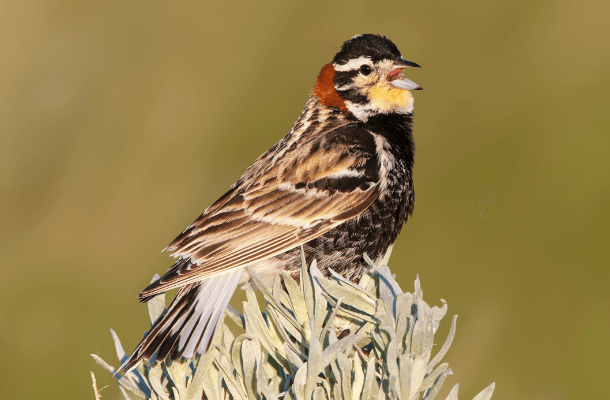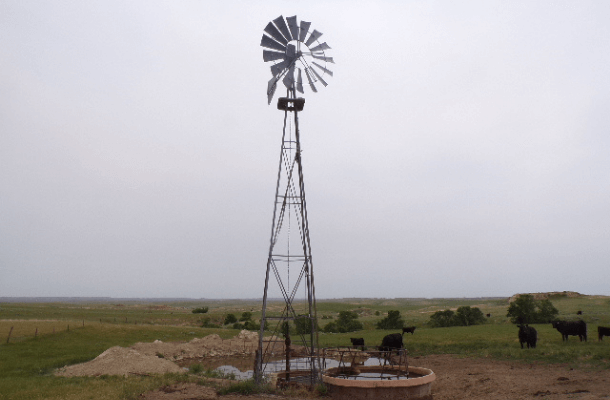Windmill Removal Improves Water Supply for Livestock While Enhancing Prairie Bird Habitat

Chestnut-collared Longspurs are among the beneficiaries of windmill removal in eastern Montana. Photo by Tim Zurowski
Windmills are an iconic sight on the landscape of eastern Montana, but often these structures no longer serve landowners, rangeland management programs, nor the ground-nesting birds that live near them. Benefiting cattle and birds alike, a new initiative that began last summer helps to bring down these obsolete structures, replacing them with efficient solar-powered pumps.
Partners in this effort include private landowners, the Natural Resources Conservation Service (NRCS) of the U.S. Department of Agriculture, the Northern Great Plains Joint Venture (NGPJV), and American Bird Conservancy (ABC).
ABC seeks to reverse declines of grassland bird populations on working ranches, without negative impacts to local economies. The organization's Northern Plains team collaborates with landowners to support diverse, well-managed rangelands using livestock grazing techniques that improve soil health, enhance water quality and yield, provide forage for livestock, and meet the habitat needs of grassland birds and other wildlife species.

A typical windmill removed and replaced with a solar-powered pump as part of a new initiative ABC is involved with. Photo by Elizabeth Emeline
The results of an extensive 2019 survey of landowners in Prairie County, Montana, conducted by the NRCS Field Office in Terry, showed that landowners are concerned that their windmills are obsolete. Not to be confused with wind turbines, these windmills are mechanical structures moved by the wind that sit atop 20- to 40-foot-tall wooden or metal towers. These devices are used specifically for pumping ground water into tanks for livestock use. Solar-powered pumps now dominate the marketplace, while parts to keep the archaic windmill systems functioning are becoming difficult to find.
A landowner's ability to sustain grasses for both livestock and wildlife depends upon having enough reliable water sources available. During calm, hot summer days when the wind speed is not enough to keep traditional windmills pumping, landowners are forced to move their animals to other areas where enough water is available to support them. Heavy use of these areas leads to a depletion of grasses and eventually the land needs a break from grazing in order for vegetation to regrow. Additionally, the tall windmill towers provide perches for predators of such declining prairie birds as the Chestnut-collared Longspur, adding further stress to already dwindling populations.
NRCS partnered with ABC to develop a Targeted Implementation Plan (TIP) to enhance habitat for prairie birds while solving the needs of livestock producers by removing windmills. NGPJV's Northern Grassland Restoration Incentives Program funded windmill disassembly and removal from the landscape, and solar-powered pumps were installed in their place with NRCS's Environmental Quality Incentives Program (EQIP) funding. NGPJV also funded bird deterrent strips to keep raptors from perching on the pumps' solar panels.
A benchmark goal was reached in the summer of 2020: Ten windmills were removed from the landscape. As replacements, solar pumps will provide a more reliable summer water supply for livestock, allowing for better management of grasslands that will enhance nesting habitat for the Chestnut-collared Longspur and Baird's Sparrow on a collective 6,400 acres in southern Prairie County, Montana. In addition to the windmills removed with the funding, several landowners removed others from their property at their own expense.
The project will continue in the southern part of the county through 2021. Going forward, the Terry NRCS Field Office plans to request funds to implement similar projects in northern Prairie County in 2022 and 2023. The TIP continues to generate a lot of interest and applications for future projects.
This successful partnership has provided an example of the beneficial outcomes of collaborations, and encouraged more landowners to sign up for the next round of TIP funds in Prairie County. Future projects could bring similar projects to landowners and land managers in other areas of Montana, as well as in Wyoming, North Dakota, and South Dakota.
“NRCS saw an opportunity to help ranchers solve ground-nesting bird and livestock-related issues in Prairie County through a Targeted Implementation Plan, and ABC is a dedicated partner in helping landowners achieve those efforts,” says Kathy Meidinger, District Conservationist in Terry.
###
Media Contact: Jordan Rutter, Director of Public Relations, 202-888-7472 | jerutter@abcbirds.org | @JERutter
Expert Contact: Elizabeth Emeline, Northern Plains Conservation Specialist | eemeline@abcbirds.org
American Bird Conservancy is a nonprofit organization dedicated to conserving wild birds and their habitats throughout the Americas. With an emphasis on achieving results and working in partnership, we take on the greatest problems facing birds today, innovating and building on rapid advancements in science to halt extinctions, protect habitats, eliminate threats, and build capacity for bird conservation. Find us on abcbirds.org, Facebook, Instagram, and Twitter (@ABCbirds).


















































